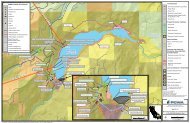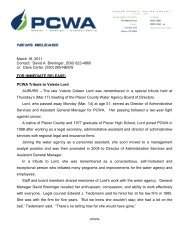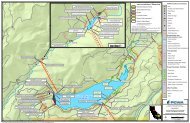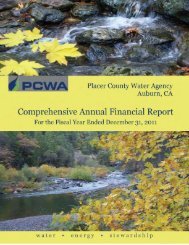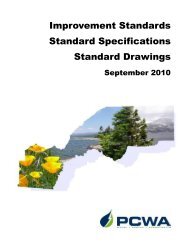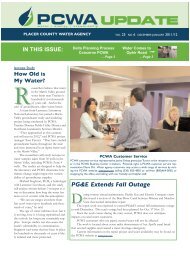Martis Valley Groundwater Management Plan - Placer County Water ...
Martis Valley Groundwater Management Plan - Placer County Water ...
Martis Valley Groundwater Management Plan - Placer County Water ...
Create successful ePaper yourself
Turn your PDF publications into a flip-book with our unique Google optimized e-Paper software.
Monitoring of Unregulated Substances<br />
Constituent Units State MCL PHG (MCLG) Range Typical Source<br />
(or MRDL) (or MRDLG) (Average) of Contaminant<br />
Sodium mg/L None None 7.9-8.7 Runoff, leaching from<br />
(8.3) natural deposits<br />
Hardness mg/L None None 75-80 Runoff, leaching from<br />
(77.5) natural deposits<br />
Radon 222 pCi/L None None 930-1600 Erosion of<br />
(1198) natural deposits<br />
Radon samples were last collected in 2001. There is no current requirement to monitor for Radon in drinking water. See below.<br />
FOR INFORMATION on water quality or questions about this report,<br />
customers are invited to contact the <strong>Placer</strong> <strong>County</strong> <strong>Water</strong> Agency Customer Services Center at<br />
(530) 823-4850 or (800) 464-0030.<br />
Environmental Influences on Drinking <strong>Water</strong><br />
The sources of drinking water (both tap and bottled<br />
water) include rivers, lakes, streams, ponds, reservoirs,<br />
springs and wells. As water travels over the<br />
surface of the land or through the ground, it dissolves<br />
naturally-occurring minerals and, in some<br />
cases, radioactive material, and can pick up substances resulting<br />
from the presence of animals or from human activity.<br />
Contaminants that may be present in source water include:<br />
• Microbial contaminants, such as viruses and bacteria, which<br />
may come from sewage treatment plants, septic systems, agricultural<br />
livestock operations, and wildlife.<br />
• Inorganic contaminants, such as salt and metals, which can<br />
Note to At-Risk <strong>Water</strong> Users<br />
Some people may be more vulnerable to contaminants in<br />
drinking water than the general population. Immunocompromised<br />
persons such as persons with cancer undergoing<br />
chemotherapy, persons who have undergone organ transplants,<br />
people with HIV/AIDS or other immune system disorders,<br />
some elderly, and infants can be particularly at risk from<br />
infections. These people should seek advice about drinking water<br />
from their health care providers. USEPA/Centers for Disease<br />
Control (CDC) guidelines on appropriate means to lessen the risk<br />
of infection by Cryptosporidium and other microbial contaminants<br />
are available from the Safe Drinking <strong>Water</strong> Hotline at (800)<br />
426-4791.<br />
2011 Testing Results<br />
Measurements reported here were collected in 2011 (unless<br />
otherwise noted). In accordance with federal regulations, data is<br />
from the most recent tests. We are allowed to monitor for some<br />
contaminants less than once per year because concentrations of<br />
these contaminants do not change frequently.<br />
Este informe contiene información muy<br />
importante sobre su agua potable.<br />
Tradúzcalo o hable con alguien que lo<br />
entienda bien.<br />
be naturally-occurring or result from urban storm water runoff,<br />
industrial or domestic wastewater discharges, oil and gas production,<br />
mining or farming.<br />
• Pesticides and herbicides, that may come from a variety of<br />
sources such as agriculture, urban storm water runoff and residential<br />
uses.<br />
• Organic chemical contaminants, including synthetic and<br />
volatile organic chemicals, which are by-products of industrial<br />
processes and petroleum production, and can also come from gas<br />
stations, urban storm water runoff, agricultural application and<br />
septic systems.<br />
• Radioactive contaminants, that can be naturally-occurring or<br />
be the result of oil and gas production and mining activities.<br />
<strong>Martis</strong> <strong>Valley</strong> System<br />
About Your <strong>Water</strong> Supply<br />
Note on Radon<br />
Radon is a radioactive gas that you can’t see, smell, or<br />
taste. It is found throughout the U.S. Radon can move<br />
up through the ground and into a home through cracks<br />
and holes in the foundation. Radon can build up to high<br />
levels in all types of homes. Radon can also get into<br />
indoor air when released from tap water from showering,<br />
washing dishes, and other household activites. Compared<br />
to radon entering a home through soil, radon entering<br />
through tap water will in most cases be a small source of<br />
radon in indoor air. Radon is a known human carcinogen.<br />
Breathing air containing radon can lead to lung cancer.<br />
Drinking water containing radon may also cause<br />
increased risk of stomach cancer. If you are concerned<br />
about radon in your home, test the air. Testing is inexpensive<br />
and easy. Fix your home if the level of radon is<br />
4 pCi/L or higher. There are simple ways to fix a radon<br />
problem that aren’t too costly.<br />
For additional information, call your State radon program<br />
(800-745-7236), the EPA Safe Drinking <strong>Water</strong> Act<br />
Hotline (800-426-4791) or the National Safe Council<br />
Radon Hotline (1-800-SOS-RADON).<br />
PAGE 3 • PCWA UPDATE




